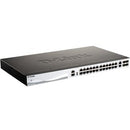Description
D-Link DGS-3130-30PS Ethernet Switch
The D-Link DGS-3130-30PS Ethernet Switch is a cutting-edge, enterprise-grade solution engineered to elevate your network’s performance, reliability, and security. Designed for secure enterprise and metro Ethernet deployments, this Lite Layer 3 stackable managed switch delivers a robust framework for connecting end users, devices, and applications with unwavering efficiency. Built to handle demanding workloads—from bandwidth-hungry video conferencing to IP-enabled security systems—the DGS-3130-30PS blends smart layering with powerful management features, ensuring that your network scales as your business grows.
- Optimized for secure enterprise networks: robust security features, access control, and segmentation to protect critical applications and data.
- Powerful Lite Layer 3 capabilities: static routing, efficient inter-VLAN routing, and enhanced traffic management to streamline data flows across the network.
- PoE+ enabled portfolio: dedicated power on select ports to simplify deployment of IP cameras, VoIP phones, and wireless access points without extra power infrastructure.
- Stackable design for scalable growth: expand capacity and resilience by stacking multiple units, delivering a unified management experience and seamless traffic distribution.
- Comprehensive management suite: intuitive web UI, CLI access, and SNMP support for centralized monitoring, configuration, and troubleshooting.
Technical Details of D-Link DGS-3130-30PS
- Model: D-Link DGS-3130-30PS
- Type: Lite Layer 3 Stackable Managed Switch
- Port configuration: 30-port Gigabit Ethernet platform, PoE-enabled on designated ports
- Power over Ethernet: PoE+ support to power compatible devices directly from the switch
- Layer 3 features: static routing, IPv4/IPv6 support, and routing efficiency for inter-network communication
- Routing and security: robust ACLs, access controls, and security measures to safeguard sensitive data and end-user devices
- Quality of Service: voice and video aware QoS to prioritize critical applications and ensure smoother performance
- Management: web-based GUI, command-line interface (CLI), and SNMP for flexible administration
- Stacking: supports stackable deployment for scalable growth and unified management across multiple units
- Uplink options: scalable uplink capabilities to connect to core or aggregation layers for optimized network design
How to Install D-Link DGS-3130-30PS
Installing the DGS-3130-30PS is designed to be straightforward for IT teams familiar with enterprise-grade switches. Start by choosing a suitable rack-mount location in a ventilated equipment rack to ensure proper airflow and cooling. Secure the switch in place, connect the power, and verify the device boots up with a healthy status indicator. Once powered, connect uplink ports to your core or distribution layer and begin configuring the switch using your preferred management method.
Step-by-step overview:
- Physically mount the switch in a standard 19-inch rack or place it on a stable surface with adequate airflow.
- Power on the device and confirm LED indicators show healthy operation.
- Connect your management workstation to a dedicated management VLAN or a dedicated management port, if available.
- Access the web-based GUI or CLI to begin initial configuration. Set up basic IP addressing, user accounts, and secure access controls.
- Configure VLANs to segment traffic by department or function, enabling proper routing between VLANs through the Lite Layer 3 features.
- Enable PoE on designated ports and allocate power budgets for IP cameras, VoIP phones, or wireless APs as needed.
- Establish QoS policies to prioritize latency-sensitive applications like video conferencing and voice over IP.
- Implement security measures such as ACLs and 802.1X port security to prevent unauthorized access and protect critical resources.
- Set up link aggregation (if supported) to increase bandwidth and provide link redundancy between switches or to the core.
- Save configurations and, if applicable, enable firmware updates to ensure you have the latest features and security patches.
For ongoing management, leverage the switch’s web GUI for day-to-day operations, while using the CLI for advanced configuration or automation. Regularly monitor performance, check port health, and review security logs to maintain an optimal network posture. The DGS-3130-30PS is designed to integrate seamlessly into heterogeneous environments, offering compatibility with a wide range of devices and standards to support a dependable, scalable network backbone.
Frequently asked questions
What is the DGS-3130-30PS best suited for?
The DGS-3130-30PS is ideal for mid-sized enterprises and metro Ethernet deployments that require a secure, scalable, and manageable switch with PoE support. It is well-suited for networks needing reliable power delivery to IP cameras, IP phones, and wireless access points while providing Layer 3 routing capabilities for efficient inter-VLAN communication.
Does the DGS-3130-30PS support PoE?
Yes. The DGS-3130-30PS includes PoE+ capable ports designed to power compatible devices directly from the switch, reducing the need for separate power adapters and simplifying installations in office environments, campus networks, or retail spaces.
Can I stack multiple DGS-3130-30PS switches?
Yes. The switch is designed to be stackable, allowing you to scale capacity and create a unified, easily managed network footprint. Stacking enables centralized configuration, simplified management, and resilient traffic distribution across switches.
What kind of management options are available?
The switch supports multiple management methods, including a web-based graphical user interface (GUI), a command-line interface (CLI), and SNMP for centralized monitoring and automation. This enables both quick setup and advanced control for IT professionals.
Is Layer 3 routing available on this model?
Yes. The DGS-3130-30PS provides Lite Layer 3 routing capabilities, including static routing and IPv4/IPv6 support. This helps optimize traffic flows between VLANs and improves network efficiency in larger deployments.
What security features should I expect?
Expect robust security capabilities, including access control lists (ACLs), secure management access, and policies designed to safeguard devices and data as it traverses the network. These features help enforce segmentation and protect sensitive resources.
Customer reviews
Showing - Of Reviews


